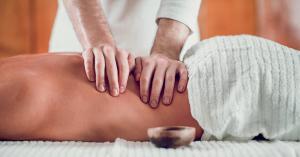
Massage in the Treatment of Cancer – Part 2
Over the course of my long career, I’ve treated many patients and have, on numerous occasions, achieved what could be described as “accidental” yet miraculous results—often for conditions that were not the primary focus of treatment.

Massage in the Treatment of Cancer part 1
The truth is, our treatment is nothing more than the stimulation of the body’s natural healing processes. As Hippocrates once said, “The natural healing force within each of us is the greatest force in getting well.” We simply assist the body in regaining its ability to heal.

Harm by “Massage” in Cases of Amyotrophic Lateral Sclerosis (ALS): Part 2
Nearly 30 years ago, when I was working as a staff trainer at a physical therapy company, the owner introduced me to one of the referring physicians, who shared a remarkable case with me. His mother, then a 55-year-old woman, had reportedly developed psychiatric symptoms.

Harm by “Massage” ?In Cases of Amyotrophic Lateral Sclerosis (ALS)? Part 1
It is not by accident that I titled this article "Harm by 'Massage'" rather than "Harm by Massage Therapy." The reason is simple: therapy implies a contribution to health improvement, while harm signifies the opposite. In all healthcare fields, there is a foundational principle: “First, do no harm.” In what situations can massage cause harm?

The placebo effect and its role in massage therapy. PART II
In Part II we are going to discuss mechanisms the therapist may use to trigger the Placebo Effect (PE) to enhance clinical effects of massage therapy and avoid activization or diminishing the negative impact of Nocebo Effect (NE). Of course, this is an introductory article.

The placebo effect and its role in massage therapy. PART I
In 1957 a patient in Long Beach, CA who suffered from multiple cancer tumors the size of oranges was given only days to live. While dying in the hospital he heard that scientists had discovered a horse serum, Krebiozen, that appeared to be very effective against cancer. He begged for them to use it on him.

Webinars? Live Classes? Online Continuing Education? What Is the Best Way to Learn and Perfect Hands-On Medical and Sports Massage?
When I arrived in the United States 33 years ago, I was hired as a staff trainer for a large physical therapy company in Southern California. This company employed over 120 physical therapists, 50 physical therapy assistants, and many speech therapists providing both inpatient and outpatient services to hospitals across the region.

Sciatica? To Ice or Not to Ice — That Is the Question
About a year ago, I developed an instructional video lesson on the application of ice massage for various musculoskeletal pain disorders, including—but not limited to—cases of nerve impingement. Over many years of writing educational materials and creating video lessons, I have not always been 100% satisfied with the final results. Sometimes, after the fact, I would think, I should have added more… clarified better…

Hands on massage procedure VS AI robotic massage, Will the Field of Massage Therapy Survive the Expansion of Artificial Intelligence?
“Feels-good” relaxation massage typically involves applying mainly effleurage techniques over the entire body during a one-hour session. This kind of massage can distract from anger and create a temporary false sense of relaxation.

Biomedical Science vs. the Science of Medical and Sports Massage – Part 2
In Part 1, in addition to other discussions, I wrote about “Medical and Sports Massage as a Distinct Science.” I apologize for repeating myself, but this distinction is crucial for both practitioners and the general public to understand.

Biomedical Science vs. The Science of Medical and Sports Massage – Part 1
From the Author
What I am about to discuss is, in my opinion, equally important for both individuals suffering from medical conditions and practitioners who apply physical treatment methods, including—but not limited to—massage therapists.

Exercise vs. Massage: The Power in Rehabilitation
Those who follow my writings know that I strongly oppose the use of alternative names for massage. According to massage trade associations, we are promoting our services under thousands of alternative names. This practice undoubtedly confuses both healthcare professionals who may want to incorporate massage into their treatments and the general public seeking help for musculoskeletal pain, stress-related illnesses, and other disorders.

Sciatic Nerve Neuralgia: Negative Impact on Other Body Systems
About 25 years ago, I had a patient suffering from fibromyalgia, whom I helped manage the condition. This patient invited me to participate in panels at a local fibromyalgia support group. During one of these meetings, I met an endocrinologist specializing in fibromyalgia treatment. Initially, he was skeptical about the role that medical massage could play in managing fibromyalgia.

We must combine medical and sports massage protocols
Boris Prilutsky will share the knowledge, clinical experiences, and personal mastery he has developed over almost 50 years of practicing medical and sports massage. This mostly hands-on seminar will be presented in a master class format. Boris on the master class: "I was trained to perform step-by-step massage protocols developed through research.

A massage therapist job could potentially be disastrous
Job-related burnout is a disease.
Most professional publications usually attribute job-related burnout to constant stress. Today, I would like to discuss burnout in healthcare fields, especially among primary care physicians/family practitioners, as well as among massage therapists.

The Role of Medical Massage in Preventing Opioid Addiction
I was amazed at how this topic resonated with my own thoughts, which I had been mulling over for a while. From the article: "A new White House study found a 400 percent jump in prescription drug abuse between 1998 and 2008. Experts blame a lack of monitoring programs as well as Americans’ increasing unwillingness to bear even small pains."





